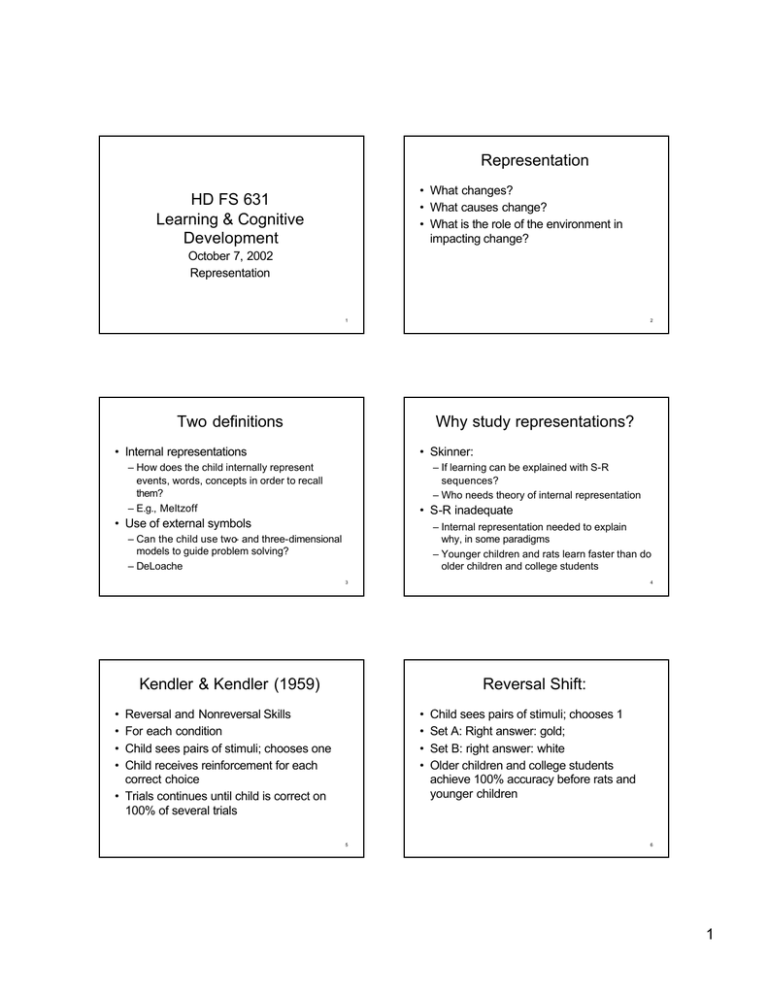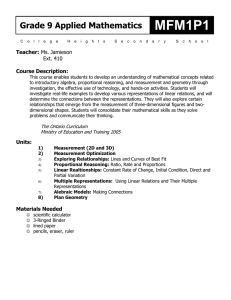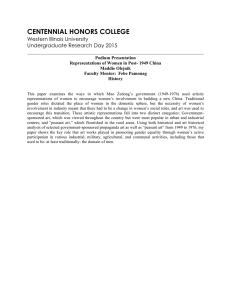Representation HD FS 631 Learning & Cognitive Development
advertisement

Representation • What changes? • What causes change? • What is the role of the environment in impacting change? HD FS 631 Learning & Cognitive Development October 7, 2002 Representation 1 2 Two definitions Why study representations? • Internal representations • Skinner: – How does the child internally represent events, words, concepts in order to recall them? – E.g., Meltzoff – If learning can be explained with S-R sequences? – Who needs theory of internal representation • S-R inadequate • Use of external symbols – Internal representation needed to explain why, in some paradigms – Younger children and rats learn faster than do older children and college students – Can the child use two- and three-dimensional models to guide problem solving? – DeLoache 3 4 Kendler & Kendler (1959) Reversal Shift: • • • • Reversal and Nonreversal Skills For each condition Child sees pairs of stimuli; chooses one Child receives reinforcement for each correct choice • Trials continues until child is correct on 100% of several trials • • • • 5 Child sees pairs of stimuli; chooses 1 Set A: Right answer: gold; Set B: right answer: white Older children and college students achieve 100% accuracy before rats and younger children 6 1 Reversal Shifts Pair 2 Pair 1 Non-Reversal Shift Pair 1 • Set A: Right answer: gold; Right Answer: small • Preschoolers and rats achieve 100% accuracy before older children and college students Pair 2 Right Right Wrong Wrong Set A Set B 7 Non-Reversal Shifts Pair 1 Pair 2 Pair 1 Explanation: Younger children use different representations of the problem Pair 2 • Which is correct stimulus? Right Right 8 – Reversal: Four changes – Non-reversal: two changes Wrong Wrong Set A • Different systems of representation – Younger children: iconic – Older children: internal mediating stimulus (black, white, small, large) Set B 9 10 Theories of representation Dual representations • Piaget • Changes in representation – Changes in representation – Sensorimotor schemes – Semiotic and perceptual schemes – Operations: Concrete; formal – use object as object and as symbol (map) • Children resist dual encoding • Except under “deceit” conditions • Bruner – Enactive – Iconic – Symbolic 11 12 2 Representation in Infancy Application of representations? • Schemes are generalized components of actions • Post: math needs to be linked • Enactive -> Iconic (Enactive) -> Symbolic (Iconic) • E -> I (E) -> S (I) – Begin in reflexive actions – Construct schemes: internal representations of actions for sucking, grasping, looting, etc. • More recent: infancy research suggests that children build representations from what they observe, not just what they do 13 Experience Expectant Synapses? 14 Mandler (1992) • Baillargeon: object permanence • Starkey -Van Loosman: numerosity (subitizing) • Wynn: Addition • Spelke: – animate/inanimate distinctions – causality • Meltzoff: – Imitation – Deferred imitation – Or do they have innate perceptual distinctions? 15 Preschoolers’ representation • We need only to grant that infants are born with a capacity to abstract certain kinds of information from perceptual displays that they will process and to redescribe them into conceptual form • I have suggested that this process is operative from at least a few months of age, which would allow concepts to develop in tandem with sensorimotor development, rather than having a later onset. 16 Use of symbols: DeLoache • Theory of mind Very young children • resist using model to stand for full size room • Unless room magically grows big! • Resist dual encoding – Autistic children lack! • Appearance/Reality Distinction (Flavell) • Phenomenalism – If it looks changed--it is changed. – Red milk is red – Except for pictures!!?? • Mutual Exclusivity in naming: Similar to dual encoding • Intellectual reality – If I know it’s a sponge, it looks like a sponge 17 – Remember Piaget’s class inclusion task: – one object cannot have two names: flower and18 daisy! 3 Errorless Retrieval: DeLoache Probabilistic Representation • Few concepts have defining criteria Percentage of Errorless Retrievals 100 • More concepts: probabilistic (Wittgenstein) 80 • Family Resemblances (Rosch & Mervis) 60 40 – Cue validity – Wings and feathers important for birds Older Younger 20 • Feature that makes it likely that objects is member depends on frequency 0 Analogous Original Locations 19 Rosch & Mervis Superordinate, subordinate, basic Basic level categories • Precede superordinate and subordinate categories • Superordinate: too much variation within groups • Subordinate: too many categories; too much similarity between groups • Basic categories Superordinate Too much variation within categories Basic Maximum cue validity – Similar shape – similar function – same motor response • Basic: cue validity maximized 21 Child basic: Vehicles Cars Animals Subordinate Too many Ford Dodge Boeing categories; too much similarity between Dogs Cats Planes Siamese Piper Calico Collie Lab 22 Scripts • Ball • Later: perceptually insignificant but functionally important (e.g., wick) relevant • Correlations among features (Younger & Cohen: 10-month olds) • Prototypes: most representative instances of concepts – Siqueland: 3-4 month olds habituate to prototype 20 • Nelson; Schank & Abelson • Scripts are very salient for young children--more salient than categories!! • Sequences of events • Affect reading performance • Fill in information from scripts • Correct errors from scripts 23 – In the restaurant, Jamie ordered cad for dinner. 24 4 Young Children’s Concepts • • • • • Older children’s concepts Concrete: “So this is Columbus.” (Piaget) Perceptual: whale = fish (Bruner) Holistic: Mother (Werner & Kaplan) Thematic: chair is to sit (Vygotsky) Global: Piaget • Abstract: Columbus is a city in Ohio • Conceptual: whale; has no scales, has mammary glands, bears live young • Analytic: Mother: one who bears? Or raises the child? • Taxonomic: chair is furniture 25 26 5








